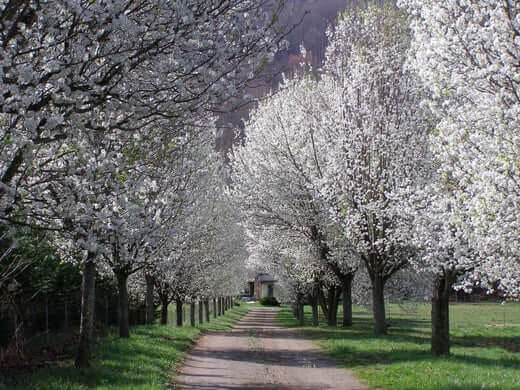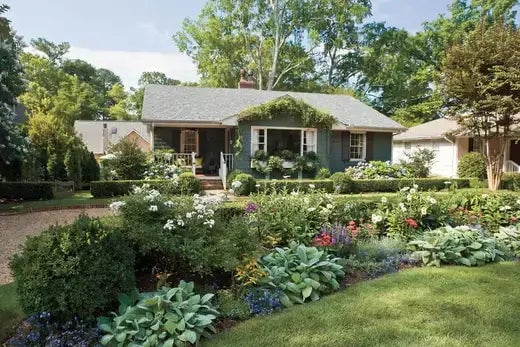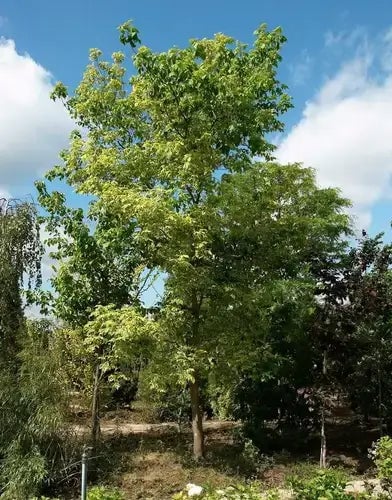The box elder, or Acer negundo, is, despite its common name, a maple.
A small, fast-growing tree can reach 35-80 feet with a trunk diameter of around 20 inches. This deciduous tree is native to most eastern United States and may still grow wild far in the Midwest states. Since it is so fast-growing, the tree is often planted as a shade tree and, like all maples, can be a source of sugary sap, which can be processed into maple sugar and maple syrup. The trunk and spreading canopy of the box elder give the tree an attractive appearance and make it a favorite for planting when reforesting or landscaping an area with native tree species.
The box elder is the only North American maple with compound leaves, which, due to their similarity to the leaves of the elder, have given it its common name.
The tree's wood is not much used in construction but is sometimes used to manufacture furniture and small wooden decorations. Not only is the box elder the only maple with compound leaves, but it is also one of the few maples that can is both male and female and can reproduce without the near presence of another tree. The seeds of the tree are encased in a samara that is reddish-brown when mature and can be seen whirling to the ground like miniature helicopters with the first winds of autumn.
A Versatile Maple with Remarkable Benefits and Planting Patterns
The box elder maple (Acer negundo) grows quickly and adapts well to different conditions throughout North America, where it originated. Box Elder provides multiple ecological, aesthetic, and practical advantages, which justify its selection for many landscaping and restoration projects despite its flashier relatives receiving more attention. Box elder supports wildlife and pollinators while demonstrating exceptional growth under challenging environments, creating advantages for natural ecosystems and human-designed landscapes. Strategic planting patterns of box elder trees improve their benefits and produce attractive, functional green spaces. This section outlines the essential benefits of box elder trees for planting purposes and strategies for maximizing their growth potential and utility.
Box Elder stands out for its exceptional endurance. Box elder survives in multiple soil types like clay, silt, and loam and grows well under wet and dry conditions. The tree's ability to adapt makes it a fitting choice for areas that experience regular flooding or soil disruption. The resilience of box elders makes it highly beneficial for restoration efforts targeting stream bank stabilization rip, Arian corridor enhancement, and brownfield redevelopment where other species fail to establish themselves. The tree's extensive root system prevents soil erosion and enables nutrient and water uptake from deep underground. Box Elder establishes itself rapidly while creating conditions for a diverse plant community to develop.
Box elder is a perfect habitat for different wildlife species through its soil-stabilizing capabilities. Its foliage, seeds, and sap provide essential nutrition to multiple insects and wildlife. Box elder beetles consume the developing leaves and seeds of the tree, while finches and grosbeaks feed on the tree's plentiful seeds. The tree's canopy provides shelter for squirrels while deer feed on its tender shoots. Box elder trees are essential for pollinating insects, including bees and butterflies. The tree produces early spring blossoms that provide a vital pollen resource despite lacking striking flowers with abundant nectar. Box elder trees support pollinators, making them a necessary element of plant communities, thereby increasing local biodiversity.
The aesthetic appeal of the box elder remains an unrecognized characteristic. Box elder trees lack the dramatic autumn coloring of sugar maples or other maple varieties, but they add a delicate yellow-to-gold display that enhances fall landscapes. The compound leaves of box elder develop distinct leaflets during the growing season, creating a lush, textured look that stands out against larger single leaves. The tree's bark starts pale gray and light brown, developing shallow ridges and furrows as it ages. A soft, elegant appearance appeals to people who prefer a natural woodland aesthetic style. Box elders require proper maintenance to serve as elegant features along rural property edges or park-like surroundings.
The box elder demonstrates practical benefits because it grows quickly. The tree offers fast-growing shade solutions for backyards, public areas, and roadside locations, which help cool these spaces during hot summer afternoons. If box elders are planted in rows or clusters, they become effective windbreaks that defend buildings and crops from strong wind gusts. Box elder trees are established quickly and propagated easily, making them financially advantageous for large-scale plantings, especially for establishing tree buffers against noise and visual intrusion from roads or industrial areas.
Thoughtful planning of planting patterns is essential to maximize these advantages. Box elder trees yield better results when planted in mixed clusters instead of uniform rows. Including native trees like cottonwoods, willows, and oaks between box elder trees effectively replicates the dynamics of natural woodlands. The approach leads to healthier soil through diverse root structures while providing layered wildlife habitats. Interspersing different tree species alongside box elders decreases the chance of pest or disease outbreaks because each species reacts differently to threats.
You can stagger the elder rows in the box to form shelterbelts or windbreaks. The initial tree row should include four to six feet spacing between trees, and a subsequent second row should follow with equal or marginally closer spacing. Aligning rows in a staggered formation produces maximum wind reduction benefits while effectively capturing drifting snow in cold weather areas. Box elder trees planted linearly along riparian water edges reduce erosion. By planting trees at ten to fifteen-foot intervals, each tree develops an extensive root network that stabilizes the bank while leaving space for other plants.
Using box elders as visual screens should be part of your landscape design strategy. Plant box elders in close-knit groups adjacent to property lines or around unattractive structures to establish a natural green barrier. The dense tree clusters serve the dual purpose of blocking unwelcome views while creating small habitats for birds and mammals that expand when accompanied by understory shrubs. Strategically arranging box elders to create arches or partial enclosures can develop peaceful groves perfect for seating areas and secluded backyard escapes.
Box elder is a valuable tree across multiple environments because of its adaptable nature and roots. It stabilizes the soil while supporting wildlife and growing quickly. Integrating this versatile maple into mixed clusters, windbreaks, riparian buffers, and ornamental groupings allows you to realize its many advantages while promoting landscape diversity and resilience. Box elder trees offer their resilience and stunning appearance to improve backyard design, help restore disturbed areas, and provide environments suitable for pollinators.
Read more

The scientific name of the Bradford Pear Tree is Pyrus calleryana. It is found in almost all the states of the US and can be grown across zones 6 – 9.They are pretty adaptable and can be grown in n...

An avid gardener or, for that matter, even a beginner is always confused about one thing: where to buy plants for their garden.Being a serious gardener, you would always want to invest in the best ...


